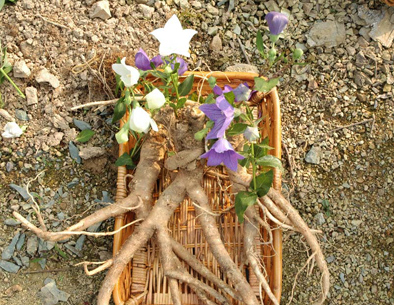Description
Details
Balloon flower roots have been consumed for their health benefits from more than 2,000 years. Balloon Flower (jie geng in Chinese) is a plant with star-shaped, blue-violet flowers. This is a popular garden plant and it is used for ornamental purposes. The balloon flower is used for culinary purposes in Korea. The Koreans use the root of the flower as an ingredient in salads and other foods. The root of the balloon flower can be prepared dried or fresh.
Balloon Flower is also known as: Jie Geng, Platycodon grandiflorum, Campanulaceae
In Korea, this flower is mentioned in traditional folk song.
The flower is one of Japan's traditional seven flowers of autumn.
Natural locations for Balloon Flower: Europe And Asia - Japan
In herbal medicine, the root is used as an anti-inflammatory agent. It is also used for the treatment of colds and coughs. Balloon Flower is used in traditional Chinese formulas for its expectorant qualities to dilate the bronchi. It reportedly increases bronchial secretions.
Health benefits of Balloon flower root:
In Korea the plant is known as doraji and its root, either dried or fresh, is a popular ingredient in salads and traditional cuisine. However, doraji (Chinese bellflower) should not be confused with Korean bellflower. Chinese bellflower is used in traditional Chinese medicine.
They are thought to work by dilating the bronchial vessels; a constituent called platycodigenin thins and helps eliminate phlegm. Recent studies found that the root killed a liver fluke (internal parasite) and lowered “bad” and raised “good” cholesterol in rats. An ingredient of several Japanese herbal extracts, the root may be anti-inflammatory. A saponin in the root increases pancreatic secretion through the release of gastrointestinal hormones.

Additional
Additional
| Health Benefits | asthma, bronchitis, coughing, lung protection, phlegm, tonsillitis |
|---|---|
| Directions | Wash 20g of herb roots on running water; boil for over 2 hours depending on symptom in 2L of water. |
| Product Package | Herb root, Paper sealed bag |
| Good herbal formulation | No |
| Storage Temperature | room temperature |
| Country of origin | Korea |
Reviews
Health
Balloon flower root is a well-known anti-inflammatory herb in Chinese medicine.
It may help in health conditions such as--
Coughs and wheezing with phlegm. Balloon flower reduces phlegm and as an expectorant, it is used to open up the lungs when they are congested and help the body get rid of pus due to a lung abscess.
Common cold, flu, bronchitis, a sore throat, and may help pulmonary tuberculosis.
Tootache
fatigue
Balloon flower root is often prescribed for loss of voice.
Balloon flower root can be found in Chinese herbalists and medical practitioners.
Opens up and disseminates lunq qi and expels phlegmPromotes the drainage of pus in the lung or throat
Benefits the throat
Directs the effect of other herbs to the upper regions of the body
Caution & Contradictions:
Hemoptysis
Counteracts with Radix Gentianae Longdancao (Long Dan Cao) and Arillus Euphoriae Longanae
Story
Origin and History
The Platycodon root actually has a long and deep history in Chinese culture. It has been used as medicine for many, many years in the country. In fact, the plant is considered to be one of the principal herbs in Chinese herbal books and literature. Aside from that, the root is also a popular ingredient in both Chinese and Japanese cuisine. They are either served fresh or dried. And because of its attractive large flowers, the plant is used as an ornament in gardens as well.
Ancient Uses
As mentioned earlier, Platycodon is one of the primary herbs used in traditional Chinese medicine. The root is believed to have a wide number of medicinal properties and benefits. The root was mainly used to treat abscesses. The herb was later used for other conditions such as inflammation of the head and the neck areas and lung disorders. Old Chinese literature refers to Platycodon as a phlegm-relieving herb. Platycodon can be used per se or it can be combined with other herbs depending on the kind of condition being treated.
FAQ
Frequently Asked Questions
A: Generally you boil 20g of tea/herb with 2L. of water. The ratio does not matter. However, it is recommended that you control the
saturation of the tea (how strong it is) depending on your personal
preference and body condition.
A: It depends on the tea/herb.
For leaves: boil for 15~20 min.
For hard fruits, roots, and stems: If you soak the tea/herb in water
for 1~2 hours before boiling, you can save time in boiling, and also
get a deeper flavor than without soaking.
A: Currently, what is listed on the site is what we mostly deal with in
retail stores. However, if there is a certain tea/herb that you wish to
get, you can send an email to info@leafnflower.com. or 844-344-0622.
Then, we may offer a price for obtaining the tea/herb, answer questions, and even offer purchase.
A: Yes, you can combine 5~10g of teas/herbs that you already have with Leafnflower.com's teas/herbs.
Although brewing one tea/herb is still good, combining 2~3 teas/herbs helps bring out
the remedial effects of the tea/herbs better than brewing just one tea/herb. However, most tea/herbs contain natural toxins,
and it is recommended that you boil 1~2 pieces of liquorice root along with the tea/herb to remove the toxin.

